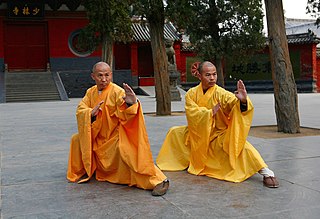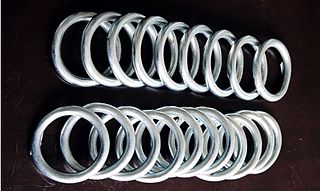
A kick is a physical strike using the leg, in unison usually with an area of the knee or lower using the foot, heel, tibia (shin), ball of the foot, blade of the foot, toes or knee. This type of attack is used frequently by hooved animals as well as humans in the context of stand-up fighting. Kicks play a significant role in many forms of martial arts, such as capoeira, kalaripayattu, karate, kickboxing, kung fu, wing chun, MMA, Muay Thai, pankration, pradal serey, savate, sikaran, silat, taekwondo, vovinam, and Yaw-Yan. Kicks are a universal act of aggression among humans.

Dao are single-edged Chinese swords, primarily used for slashing and chopping. They can be straight or curved. The most common form is also known as the Chinese sabre, although those with wider blades are sometimes referred to as Chinese broadswords. In China, the dao is considered one of the four traditional weapons, along with the gun, qiang (spear), and the jian, called in this group "The General of Weapons".

Chinese martial arts, commonly referred to with umbrella terms kung fu, kuoshu or wushu, are multiple fighting styles that have developed over the centuries in Greater China. These fighting styles are often classified according to common traits, identified as "families" of martial arts. Examples of such traits include Shaolinquan (少林拳) physical exercises involving All Other Animals (五形) mimicry or training methods inspired by Old Chinese philosophies, religions and legends. Styles that focus on qi manipulation are called internal, while others that concentrate on improving muscle and cardiovascular fitness are called external. Geographical associations, as in northern and southern, is another popular classification method.

Bajiquan is a traditional Chinese martial art that features explosive, short-range power in close-combat and is well known for its rapid elbow and shoulder strikes. Its full name is kaimen bajiquan.

Changquan refers to a family of external martial arts styles from northern China.

A Nandao is a kind of dao, or single-edged sword, that is used in contemporary wushu taolu. Ratified for use by the International Wushu Federation in 1992, it has gained widespread popularity worldwide and has become one of the main events at wushu competitions.

The front kick in martial arts is a kick executed by lifting the knee straight forward, while keeping the foot and shin either hanging freely or pulled to the hip, and then straightening the leg in front of the practitioner and striking the target area. It is desirable to retract the leg immediately after delivering the kick, to avoid the opponent trying to grapple the leg and to return to stable fighting stance.

Nanquan refers to a classification of Chinese martial arts that originated in Southern China.
The lotus kick, also known as the jump outside or téng kōng bǎi lián is a popular jump in modern wushu taolu.

The foot sweep is a move in many different styles of martial arts. It refers to the use of any part of the foot or leg to trip an opponent or cause them to lose balance. Foot sweeps as an act of human aggression have likely existed worldwide since prehistory, which explains why it is prevalent in many martial arts across the world. However, the earliest documentation of foot sweeps used in self-defense, sport fighting and combat is seen in Chinese Martial arts, Judo, Jujutsu as well as Karate and Muay Thai.
The different slow motion solo form training sequences of tai chi are the best known manifestations of tai chi performed for the general public. The forms are usually performed slowly by beginners and are designed to promote concentration, condition the body and familiarize students with the inventory of motion techniques for more advanced styles of martial arts training. There are also solo weapons forms, as well as much shorter and repetitive sequences to train power generation leverages. The laojia yi lu postures listed below are the "old frame, first routine" of the Chen style with focus on silk reeling.

The horse stance is a common posture in Asian martial arts. It is called mǎbù (馬步) in Chinese, kiba-dachi (騎馬立ち) in Japanese, and juchum seogi or annun seogi in Korean. This stance can not only be integrated into fighting but also during exercises and forms. It is most commonly used for practicing punches or to strengthen the legs and back. The modified form of horse stance, in which heels are raised, is a fighting stance in International Karate Tournaments. The Chinese form of horse stance is a fighting stance which changes into front stance while using hip rotation to develop punching force.

Ziranmen, also known as Natural Boxing, is a Northern internal style of kung fu that is taught in conjunction with qigong breathing techniques. The style traces its lineage to Dwarf Xu, who based it on ancient Taoist philosophy. Du Xinwu, the next bearer of the lineage, served as a bodyguard to Sun Yat-sen, then the provisional president of the Republic of China. Du imparted his knowledge of "Natural Boxing" to his eldest son Du Xiusi and Wan Laisheng, a prominent twentieth century martial artist.

A roundhouse kick is a kick in which the practitioner lifts the knee while turning the supporting foot and body in a semicircular motion, extending the leg striking with the lower part of the shin and/or the instep. The ball of the foot can also be used to strike the target and is preferable when power breaking thick boards. This type of kick is utilized in many different martial arts and is popular in both non-contact and full-contact martial arts competitions. The kick has many variations based on stance, leg movement, striking surface, and the height of the kick.

Footwork is a martial arts and combat sports term for the general usage of the legs and feet in stand-up fighting. Footwork involves keeping balance, closing or furthering the distance, controlling spatial positioning, and/or creating additional momentum for strikes.

Taijijian is a straight two-edged sword used in the training of the Chinese martial art tai chi. The straight sword, sometimes with a tassel and sometimes not, is used for upper body conditioning and martial training in traditional tai chi schools. The different family schools have various warmups, forms and fencing drills for training with the double-edged sword known as jian.

Chuojiao is a Chinese martial art that comprises many jumps, kicks, and fast fist sequences. The fist and feet work in unison and strike continuously forward, like "falling meteorites", never giving the opponent a moment to recover. The qinggong portion of this style's training involves a practitioner jumping against a wall with heavy weights affixed to his/her calves. This style is practiced mainly in northern and northeast China, including central Hebei, Beijing, and Liaoning.
Karate has many different stances, each used for different types of power and movement. In Japanese the general term is tachi (立ち) changed to dachi when used as a suffix. Some stances focus more on mobility than stability, and vice verse.

In martial arts, stances are the distribution, foot orientation and body positions adopted when attacking, defending, advancing, or retreating. In many Asian martial arts, the most widely used stance is a shallow standing squat. This position is generally employed as it is a neutral and agile position from which both attacks and defences may be launched. It provides for the delivery of force when attacking and stability when defending.
Wu-style tai chi fast form is a suite of fast forms publicized in Wu-style T'ai chi Fast Form.












